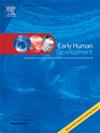The effects of early enteral feeding, fortification, and rapid feeding advancement in extremely low birth weight infants
IF 2.2
3区 医学
Q2 OBSTETRICS & GYNECOLOGY
引用次数: 0
Abstract
Background
Preterm infants are at risk for necrotizing enterocolitis (NEC) and sepsis. Optimal strategies of preterm feeding to achieve full enteral feeding early with minimal duration of central lines without increasing the risk of NEC remain uncertain. We aimed to evaluate if new enteral feeding strategies reflecting early initiation, fortification, and more rapid advancement is beneficial without increasing the risk of NEC.
Methods
We performed a retrospective cohort study including 122 infants born with birth weight < 1000 g during Period 1 (old feeding protocol, n = 61) and Period 2 (new feeding protocol, n = 61) to compare the incidence of NEC, late-onset sepsis, the duration of central line, and the growth outcomes before and after the implementation of feeding strategies to reflect early initiation of feeding within 12 h of life, early fortification at 60 mL/kg/day, and more rapid feeding advancement up to 30 mL/kg/day.
Result
Median time to reach full enteral feeds was decreased from 9 to 6 days (p < 0.001). The duration of central venous catheters was also improved from median 7 to 5 days (p < 0.001). The incidence of NEC was not different (11.5 % in Period 1 vs. 8.2 % in Period 2, p = 0.54). 14 infants (23 %) had late-onset sepsis in Period 1 vs. 8 infants (13.1 %) in Period 2 (p = 0.16). The growth outcome was comparable between the two periods (p = 0.47).
Conclusion
Earlier initiation of enteral feeding and fortification, and more rapid advancement were safely introduced with significantly shorter duration of central lines without increasing the incidence of NEC.
早期肠内喂养、强化和快速喂养对极低出生体重儿的影响。
背景:早产儿有坏死性小肠结肠炎(NEC)和败血症的风险。早产儿喂养的最佳策略是在不增加NEC风险的情况下,尽早实现全肠内喂养,缩短中心静脉插管时间。我们的目的是评估反映早期开始,强化和更快速进展的新的肠内喂养策略是否有益而不增加NEC的风险。方法:我们进行了一项回顾性队列研究,包括122名出生体重的婴儿。结果:达到完全肠内喂养的中位时间从9天减少到6天(p)。结论:更早开始肠内喂养和强化,更快速的推进是安全的,中心线的持续时间显著缩短,而不会增加NEC的发生率。
本文章由计算机程序翻译,如有差异,请以英文原文为准。
求助全文
约1分钟内获得全文
求助全文
来源期刊

Early human development
医学-妇产科学
CiteScore
4.40
自引率
4.00%
发文量
100
审稿时长
46 days
期刊介绍:
Established as an authoritative, highly cited voice on early human development, Early Human Development provides a unique opportunity for researchers and clinicians to bridge the communication gap between disciplines. Creating a forum for the productive exchange of ideas concerning early human growth and development, the journal publishes original research and clinical papers with particular emphasis on the continuum between fetal life and the perinatal period; aspects of postnatal growth influenced by early events; and the safeguarding of the quality of human survival.
The first comprehensive and interdisciplinary journal in this area of growing importance, Early Human Development offers pertinent contributions to the following subject areas:
Fetology; perinatology; pediatrics; growth and development; obstetrics; reproduction and fertility; epidemiology; behavioural sciences; nutrition and metabolism; teratology; neurology; brain biology; developmental psychology and screening.
 求助内容:
求助内容: 应助结果提醒方式:
应助结果提醒方式:


